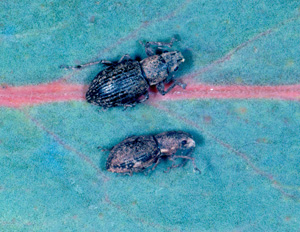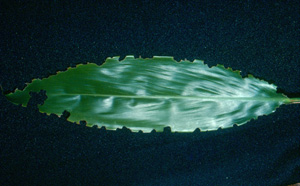Fuller Rose Beetle

Photo: Dr. Arnold H. Hara, CTAHR
Problem
Margins of leaves on plants have been chewed on.
Description
Fuller rose beetle larvae feed on the roots of plants; adult beetles feed on leaves, leaving ragged sections. They may also feed on the flowers. Damage to leaves is different from that of Chinese rose beetle in that Fuller rose beetles feed from the edge of the leaf inward. Chinese rose beetles leave a lacy effect.

Photo: Dr. Arnold H. Hara, CTAHR
Information
- Fuller Rose Beetle (University of California, IPM On-line)
Control
If damage is not severe, you can ignore it. Fuller rose beetles feed at night and burrow at the base of plants during the day. You can apply a 6 inch band of sticky material to the trunk of the tree to trap beetles. Or wrap burlap around the base of the tree and check for beetles hiding there once a week. You could also try using a buried trap (see UC Davis Pest Notes – Fuller rose beetle – Traps for instructions)
Kendal Lyon, Hawaii Island Master Gardeners

